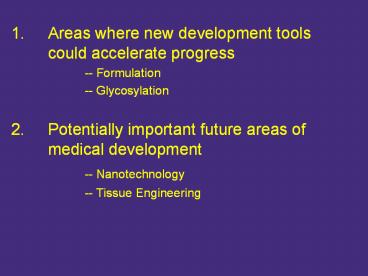1.Areas where new development tools could accelerate progress - PowerPoint PPT Presentation
1 / 30
Title:
1.Areas where new development tools could accelerate progress
Description:
Informatics; data mining, learning. Case Study: Ritonavir ... Over $500 billion in health care costs. 40 to 90 million hospital days ... – PowerPoint PPT presentation
Number of Views:31
Avg rating:3.0/5.0
Title: 1.Areas where new development tools could accelerate progress
1
- 1. Areas where new development tools could
accelerate progress - -- Formulation
- -- Glycosylation
- 2. Potentially important future areas of medical
development - -- Nanotechnology
- -- Tissue Engineering
2
Impact of TransForm Technology
Traditional
TransForm
of F F experiments
- 200-20,000
- 10-20
Ability to explore FF space more effectively and
efficiently
Timing
- 2 4 Weeks
- 1 2 Months
Informatics data mining, learning
- Deep iterative
- Minimal
3
(No Transcript)
4
Case Study Ritonavir
- 1.5 years after launch, converted into
unanticipated form II polymorph - 50 less soluble
- Abbott compelled to recall reformulate
MPT 122 C
MPT 125 C
MPT 80 C
MPT 97 C
MPT 116 C
Form I
Form II
Form III
Form IV
Form V
- Within weeks at TransForm, using lt 2g
- Both known forms identified characterized
- Found three novel, previously unreported forms
- Novel, robust methods to make each form
Morissette et al. PNAS 100, 2180 (2003).
5
New Tools
- Imaging
- Informatics
- Genomics
- Proteomics
- 5. Glycomics
6
Cracking the Code of Sugars is Analogous to
the Sequencing of DNA
- The sequencing of DNA has laid the foundation for
biotechnology revolution - Like DNA and proteins, sugars play a central role
in regulating basic biological activity, disease
mechanisms, and drug action - Sugars exist as sequences of building blocks
similar to DNA, but there has been a lack of
adequate sequencing tools - Understanding of sugars is critical for
polysaccharide drugs (e.g. Lovenox) and
glycosylated proteins (e.g. Epogen)
7
Inherent complexity of sugars has prevented
comprehensive understanding
- Structural complexity and information density
- Lack of amplification
- Heterogeneity
The Problem Lack of technology to and tools to
sequence sugars has made it difficult to
characterize and engineer sugars, and decipher
their role in biology.
8
Convergence on unique solution to complex
sequences
Sequencing Complex Polysaccharides 1999 Science
286 537-542. Momenta Pharmaceuticals
9
Future areas of medical development
1. Nanotechnology 2. Tissue Engineering
10
Prototype Device
Silicon Nitride or Dioxide
Silicon
Active Substance
Cathode
Anode
11
Implantable Drug Delivery System
Battery-powered, telemetry-controlled implant
Design based on pacemaker and ICD microelectronics
12
Reservoir Opening Mechanism
13
Pre-Clinical Studies Demonstrate in vivo Release
- Experimental Protocol
- Implant microchips subcutaneously in rats
- Release radioactive mannitol (388 ng/well
non-metabolized sugar) - Collect urine and analyze for radioactive
content - as an indicator of drug release
14
Polymer Therapeutics Nanosized medicines
polymer-protein conjugate
polymeric drug or sequestrant
protein
Mw 5 - 40,000 Da
20nm
40-60 nm
5-15 nm
targeting residue
hydrophilic block
drug
linker
hydrophiobic block
drug
polymer-drug conjugates
polymeric micelle
60-100 nm
15
1. How do you assess safety? 2. How do you
characterize nanomedicines --Biological --P
hysical/chemical 3. What animal models are
appropriate?
16
Annual Tissue LossEnd Stage Organ Failure (U.S.)
- Over 500 billion in health care costs
- 40 to 90 million hospital days
- 8 million surgical procedures
17
Incidence of Organ and Tissue Deficiencies
- Bone
- Joint replacement 558,000
- Bone graft 275,000
- Internal fixation 480,000
- Facial reconstruction 30,000
- Cartilage
- Patella 319,400
- Meniscus 250,000
- Arthritis (Knee) 149,900
- Arthritis (Hip) 219,300
- Small Joints 179,000
- Tendon 33,000
- Ligament 90,000
- Skin
- Burns, Sores, 3,650,000
- Ulcers 1,100,000
- Heart 754,000
- Blood Vessels 606,000
- Liver 205,000
- Pancreas 728,000
18
(No Transcript)
19
(No Transcript)
20
Cartilage Tissue Engineering
BEFORE cell seeding
AFTER 2 weeks in culture
21
(No Transcript)
22
System
- Modified PGA Tubes
- 8 Weeks SMC Culture, then EC
- Bio-Reactors Pulsatile Radial Stress
23
(No Transcript)
24
(No Transcript)
25
Characteristics
- 50 Collagen
- Rupture Strengths gt 2000 mg Hg
- Suture Retention Strengths up to 90g
- Demonstrates Contractile Responses to Serotonin,
endothelin-1, and Prostaglandin F2a
26
(No Transcript)
27
Human Embryonic Endothelial Cells Form Functional
Blood-Carrying Microvessels
PECAM1
CD34
28
(No Transcript)
29
(No Transcript)
30
- How should safety be assessed?
- What are appropriate markers?
- How do you determine appropriate function?
- What are appropriate animal models?

